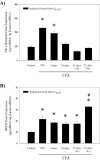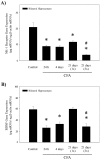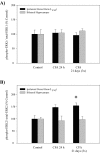Neurokinin-1 (NK-1) receptor and brain-derived neurotrophic factor (BDNF) gene expression is differentially modulated in the rat spinal dorsal horn and hippocampus during inflammatory pain
- PMID: 17974009
- PMCID: PMC2174921
- DOI: 10.1186/1744-8069-3-32
Neurokinin-1 (NK-1) receptor and brain-derived neurotrophic factor (BDNF) gene expression is differentially modulated in the rat spinal dorsal horn and hippocampus during inflammatory pain
Abstract
Persistent pain produces complex alterations in sensory pathways of the central nervous system (CNS) through activation of various nociceptive mechanisms. However, the effects of pain on higher brain centers, particularly the influence of the stressful component of pain on the limbic system, are poorly understood. Neurokinin-1 (NK-1) receptors and brain-derived neurotrophic factor (BDNF), known neuromediators of hyperalgesia and spinal central sensitization, have also been implicated in the plasticity and neurodegeneration occurring in the hippocampal formation during exposures to various stressors. Results of this study showed that injections of complete Freund's adjuvant (CFA) into the hind paw increased NK-1 receptor and BDNF mRNA levels in the ipsilateral dorsal horn, supporting an important role for these nociceptive mediators in the amplification of ascending pain signaling. An opposite effect was observed in the hippocampus, where CFA down-regulated NK-1 receptor and BDNF gene expression, phenomena previously observed in immobilization models of stress and depression. Western blot analyses demonstrated that in the spinal cord, CFA also increased levels of phosphorylated cAMP response element-binding protein (CREB), while in the hippocampus the activation of this transcription factor was significantly reduced, further suggesting that tissue specific transcription of either NK-1 or BDNF genes may be partially regulated by common intracellular transduction mechanisms mediated through activation of CREB. These findings suggest that persistent nociception induces differential regional regulation of NK-1 receptor and BDNF gene expression and CREB activation in the CNS, potentially reflecting varied roles of these neuromodulators in the spinal cord during persistent sensory activation vs. modulation of the higher brain structures such as the hippocampus.
Figures





References
Publication types
MeSH terms
Substances
Grants and funding
LinkOut - more resources
Full Text Sources
Other Literature Sources
Medical

